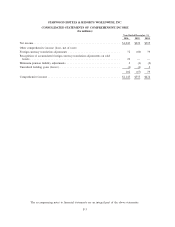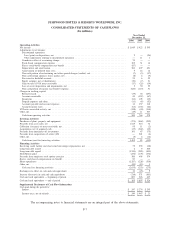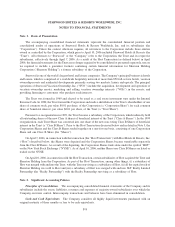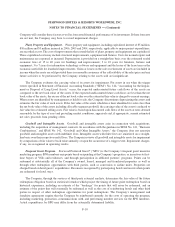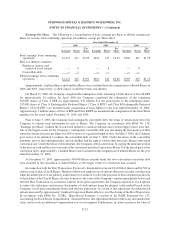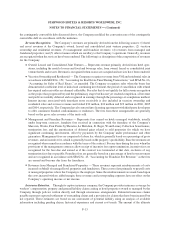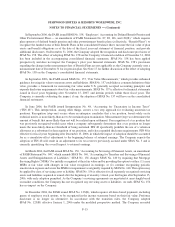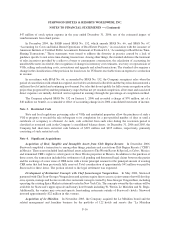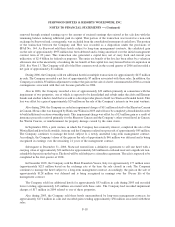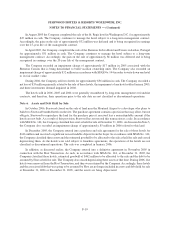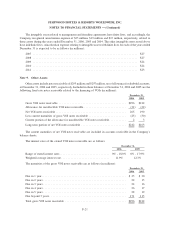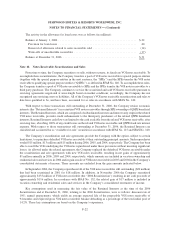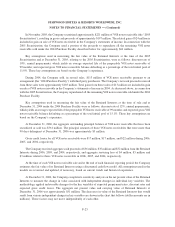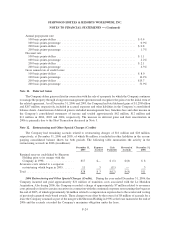Starwood 2006 Annual Report Download - page 76
Download and view the complete annual report
Please find page 76 of the 2006 Starwood annual report below. You can navigate through the pages in the report by either clicking on the pages listed below, or by using the keyword search tool below to find specific information within the annual report.In September 2006, the FASB issued SFAS No. 158, “Employers’ Accounting for Defined Benefit Pension and
Other Postretirement Plans — an amendment of FASB Statements No. 87, 88, 106, and 132(R),” which requires
plan sponsors of defined benefit pension and other postretirement benefit plans (collectively, “Benefit Plans”) to
recognize the funded status of their Benefit Plans in the consolidated balance sheet, measure the fair value of plan
assets and benefit obligations as of the date of the fiscal year-end statement of financial position, and provide
additional disclosures. On December 31, 2006, the Company adopted the recognition and disclosure provisions of
SFAS No. 158. The effect of adopting SFAS No. 158 on the Company’s financial condition at December 31, 2006
has been included in the accompanying consolidated financial statements. SFAS No. 158 has been applied
prospectively and does not impact the Company’s prior year financial statements. SFAS No. 158’s provisions
regarding the change in the measurement date of Benefit Plans are not applicable as the Company currently uses a
measurement date of December 31 for its pension plan. See Note 17 for further discussion of the effect of adopting
SFAS No. 158 on the Company’s consolidated financial statements.
In September 2006, the FASB issued SFAS No. 157, “Fair Value Measurements,” which provides enhanced
guidance for using fair value to measure assets and liabilities. SFAS No. 157 establishes a common definition of fair
value, provides a framework for measuring fair value under U.S. generally accepted accounting principles and
expands disclosure requirements about fair value measurements. SFAS No. 157 is effective for financial statements
issued in fiscal years beginning after November 15, 2007, and interim periods within those fiscal years. The
Company is currently evaluating the impact, if any, the adoption of SFAS No. 157 will have on the consolidated
financial statements.
In June 2006, the FASB issued Interpretation No. 48, “Accounting for Uncertainty in Income Taxes”
(“FIN 48”). This interpretation, among other things, creates a two step approach for evaluating uncertain tax
positions. Recognition (step one) occurs when an enterprise concludes that a tax position, based solely on its
technical merits, is more-likely-than-not to be sustained upon examination. Measurement (step two) determines the
amount of benefit that more-likely-than-not will be realized upon settlement. Derecognition of a tax position that
was previously recognized would occur when a company subsequently determines that a tax position no longer
meets the more-likely-than-not threshold of being sustained. FIN 48 specifically prohibits the use of a valuation
allowance as a substitute for derecognition of tax positions, and it has expanded disclosure requirements. FIN 48 is
effective for fiscal years beginning after December 15, 2006, in which the impact of adoption should be accounted
for as a cumulative-effect adjustment to the beginning balance of retained earnings. The Company expects the
adoption of FIN 48 will result in an adjustment to its tax reserves previously accrued under SFAS No. 5 and is
currently quantifying the overall impact to retained earnings.
In March 2006, the FASB issued SFAS No. 156, “Accounting for Servicing of Financial Assets, an amendment
of FASB Statement No. 140,” which amends SFAS No. 140, “Accounting for Transfers and Servicing of Financial
Assets and Extinguishments of Liabilities.” SFAS No. 156 changes SFAS No. 140 by requiring that Mortgage
Servicing Rights (“MSRs”) be initially recognized at their fair value and by providing the option to either: (1) carry
MSRs at fair value with changes in fair value recognized in earnings; or (2) continue recognizing periodic
amortization expense and assess the MSRs for impairment as originally required by SFAS No. 140. This option may
be applied by class of servicing asset or liability. SFAS No. 156 is effective for all separately recognized servicing
assets and liabilities acquired or issued after the beginning of an entity’s fiscal year that begins after September 15,
2006, with early adoption permitted. As the Company’s servicing agreements are negotiated at arms-length based
on market conditions, the Company has not recognized any servicing assets or liabilities. As such, SFAS No. 156
has no impact on the Company.
In December 2004, the FASB issued SFAS No. 123(R), which requires all share-based payments, including
grants of employee stock options, to be recognized in the income statement based on their fair value. Proforma
disclosure is no longer an alternative. In accordance with the transition rules, the Company adopted
SFAS No. 123(R) effective January 1, 2006 under the modified prospective method. The Company recorded
F-15
STARWOOD HOTELS & RESORTS WORLDWIDE, INC.
NOTES TO FINANCIAL STATEMENTS — (Continued)


